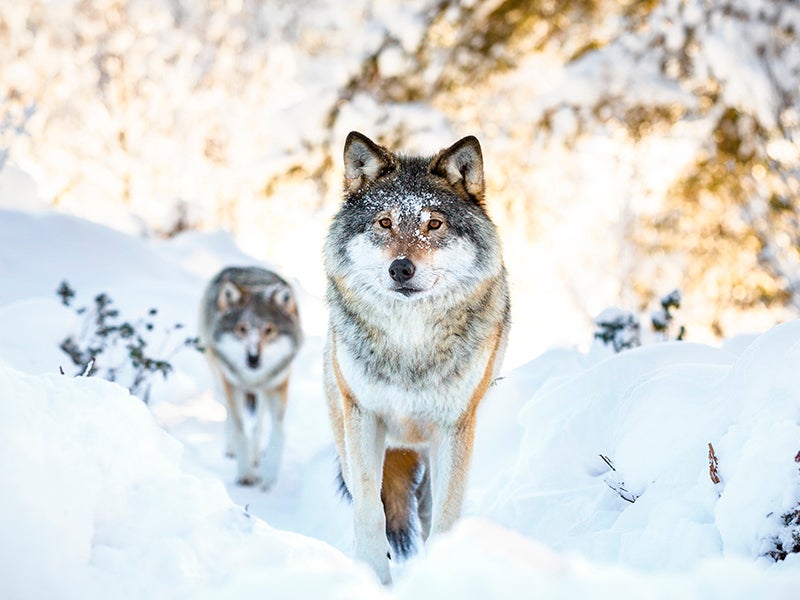Out for Blood: Legislators Escalate Their War on Wolves
Some legislators have pushed an all-out war on wolves for years. Now they’re going in for the ultimate kill: gutting the very law that protects this iconic species.

This page was published 7 years ago. Find the latest on Earthjustice’s work.
One dead wolf, every three hours.
That’s how quickly a dozen wolves were shot and killed during the first 40 hours of Wyoming’s inaugural wolf hunt last fall. The state-sanctioned hunt began after Endangered Species Act (ESA) protections for Wyoming wolves were removed in April 2017, much to the dismay of scientists and groups like Earthjustice. At the end of the season, hunters killed a total of 76 wolves, but that number doesn’t include the countless others who found themselves trapped in Wyoming’s “Predator Zone,” an area that covers almost 90 percent of the state in which wolves and their pups may be killed at any time, by almost any means.
Wyoming’s wolves are just the latest casualty in an all-out war that anti-wildlife politicians have waged for more than two decades since wolves were first reintroduced to the wild in the northern Rocky Mountains. The species was almost wiped out entirely in the 1930s by government-sponsored eradication programs. Bounty hunters strung up rows of ten or more dead wolves as the men kneeled in front of the carcasses, posing for the camera.
Recognizing that extinction is irreversible, the United States did in 1973 what no country had done before, establishing a commitment to protect and restore species like gray wolves that are most at risk of extinction. With their reintroduction in the mid-1990s, the iconic gray wolf has made an incredible comeback, with wolf packs slowly returning to their natural habitat in the Northern Rockies, as well as the Great Lakes and the Pacific Northwest.
Thanks to these federal protections, the howl of the wolf in the wild can be heard once more. Yet anti-wolf factions are intent on eliminating the gray wolf again so that a few private industries can benefit. Their efforts thus far have been deadly successful. Since 2011, when the federal government permanently dropped gray wolf protections in Montana and Idaho, more than 2,500 wolves have been killed.
Anti-wolf factions in Congress have now turned their attention to pushing for laws that expand their war on wolves. They seek to block Endangered Species Act protections for wolves in three Midwest states, as well as codify the current delisting in Wyoming into law, making it more difficult to challenge management plans even if the species’ population starts to crash. Further, this legislation aims to bar judicial review of these delistings, undermining citizen access to the courts and efforts to help protect these populations of wolves.
Wolves aren’t the only ones on these anti-wildlife crusaders’ hit list. This year, legislators have included a whopping 12 anti-wildlife “riders”—that is, unrelated pieces of legislation—in must-pass government spending bills. These riders attack imperiled species by undermining the Endangered Species Act, the law that serves as the safety net for the world’s most threatened plants and animals.
In addition to these 12 government spending riders, Earthjustice is keeping a close eye on an upcoming House floor vote on the “Wildlife Extinction Package,” a set of five bills that seek to weaken the Endangered Species Act. We are also awaiting a regulatory overhaul targeting the Endangered Species Act that the Trump Administration will likely be proposing this spring.
These political attacks, designed to benefit only a few special interests, couldn’t come at a worse time for our nation’s wildlife. Scientists believe we are currently undergoing the sixth mass wave of extinction ever to impact our planet, and the first wave to ever have been caused by one of Earth’s species—that is, humans. Upholding the Endangered Species Act and the vital protections it affords is one of the surest ways to prevent a species’ extinction. Over the past four decades, the act has prevented the extinction of more than 99 percent of the species under its care, including southern resident killer whales, grizzly bears, wolverines, manatees, and our nation’s symbol, the bald eagle. Given its numerous successes, it’s no wonder that the public quite simply loves this act and doesn’t want to see it destroyed or weakened.
Yet the act’s successes could all be taken away in a heartbeat if anti-environment factions in the House and Senate—backed by trophy hunting organizations, oil and gas interests, mining companies and others—have their way. We can’t let that happen.
Established in 1993, Earthjustice's Northern Rockies Office, located in Bozeman, Mont., protects the region's irreplaceable natural resources by safeguarding sensitive wildlife species and their habitats and challenging harmful coal and industrial gas developments.
Established in 1989, Earthjustice's Policy & Legislation team works with champions in Congress to craft legislation that supports and extends our legal gains.